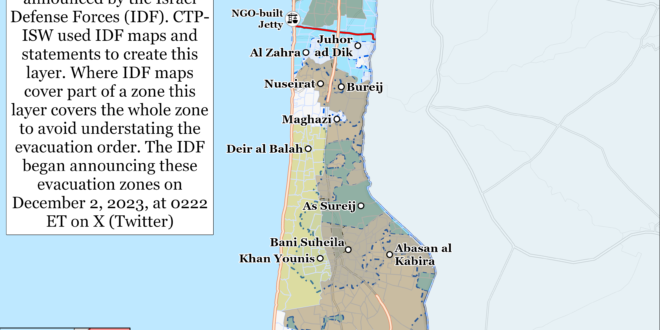The Masoud Pezeshkian administration is continuing to signal its willingness to pursue nuclear negotiations with the West. Iranian media reported on September 2 that Foreign Affairs Minister Abbas Araghchi appointed Majid Takht Ravanchi as deputy foreign affairs minister for political affairs.[1] Araghchi has not officially announced Ravanchi’s appointment at the time of this writing. Ravanchi was part of the Iranian nuclear negotiating team under former President Hassan Rouhani that helped conclude the 2015 Joint Comprehensive Plan of Action (JCPOA) between Iran and the P5+1.[2] The P5+1 is composed of the five permanent members of the UN Security Council plus Germany.[3] Ravanchi also served as the Iranian ambassador to the UN between April 2019 and August 2022.[4] Pezeshkian’s appointment of Araghchi—who himself played a prominent role in the nuclear negotiations under Rouhani—as Iranian foreign affairs minister and Araghchi’s appointment of Ravanchi as his political deputy underscores the Pezeshkian administration’s serious intent to resume nuclear negotiations with the West. International Atomic Energy Agency (IAEA) Director General Rafael Grossi separately stated that Pezeshkian has indicated to him “a potential for renewed dialogue aimed at ensuring the peaceful nature of Iran’s nuclear activities” during an interview with Saudi-owned al Arabiya on September 2.[5] Grossi previously indicated on August 30 that Pezeshkian had agreed to a bilateral meeting in the “near future.”[6] It is unclear to what extent Supreme Leader Ali Khamenei will permit the Pezeshkian administration to pursue nuclear negotiations with the West, although Khamenei has expressed support in recent weeks for engaging in negotiations in order to remove international sanctions on Iran.[7]
Iran is expected to “imminently” deliver ballistic missiles to Russia to support the Russian invasion of Ukraine.[8] An unspecified European official told Bloomberg on September 2 that Iran could begin shipping ballistic missiles to Russia “within a matter of days.”[9] European intelligence sources previously told Reuters in August 2024 that Iran and Russia signed a contract in December 2023 for Iran to deliver Ababil close-range ballistic missiles and Fateh-360 short-range ballistic missiles to Russia.[10] The intelligence sources added that dozens of Russian military personnel are currently training in Iran on how to operate Fateh-360 missiles. Russia’s acquisition of Ababil or Fateh-360 ballistic missiles would likely allow Russian forces to strike Ukrainian near-rear targets while reserving Russia’s own missile stockpiles (such as Iskander missiles) for deep-rear Ukrainian targets, as CTP-ISW previously assessed.[11]
Iranian Supreme National Defense University President Brigadier General Esmail Ahmadi Moghaddam stated on September 2 that keeping Israel in a state of anxiety is “no less than a military strike.”[12] Moghaddam claimed that Iran will have a “wise reaction” to Ismail Haniyeh’s death. Moghaddam’s statements are consistent with those from senior Iranian officials discussing Iran’s “psychological war” against Israel.[13] Moghaddam is not within the Iranian chain of command but his statements are representative of the larger ongoing public conversation in Iranian defense and security circles discussing the merits of employing ”psychological warfare” against Israel.[14]
Hamas released hostage propaganda on September 2 that likely intended to increase domestic Israeli pressure that Hamas likely calculates could create more favorable terms for Hamas in a ceasefire agreement and weaken the Israeli state. Hamas released propaganda videos featuring six recently executed Israeli hostages on September 2 calling for a ceasefire and hostage-for-prisoner exchange.[15] Hamas also released a graphic in Hebrew stating that Israel will only secure the release of living hostages through negotiations not military operations.[16] Hamas has previously released hostage propaganda during periods of unrest and during ceasefire negotiations.[17] These videos are part of an information operation that aims to undermine Israeli public support for the ground operation in the Gaza Strip. Hamas leaders likely seek to exacerbate the tensions in the Israeli domestic sphere and cause further psychological distress by airing this propaganda. Hamas leaders may believe that that the Israeli public and officials will increase pressure on Israeli Prime Minister Netanyahu to drop demands from ceasefire negotiations that Hamas dislikes, such as a continued control over the Philadelphi Corridor. Maintaining Israeli control of the Philadelphi Corridor would help prevent Hamas and other Palestinian militias from rebuilding their capabilities quickly by interdicting major smuggling operations into the Gaza Strip that would accelerate Hamas’ ability to resupply itself, as CTP-ISW has previously argued.[18]
Israeli political and military leaders argued over the best path to a ceasefire-hostage deal on September 1 after Hamas executed six Israeli hostages in the Gaza Strip. Israeli Defense Minister Yoav Gallant criticized the August 29 decision by Israeli’s political-security cabinet to back Netanyahu’s proposal to maintain an IDF presence on the Philadelphi Corridor.[19] Gallant reportedly argued in a private cabinet meeting that prioritizing IDF control over the Philadelphi Corridor for six weeks over securing the release of dozens of living hostages is the wrong decision and should be reversed.[20] Gallant said that the IDF could retake the corridor in eight hours if it withdrew.[21] Netanyahu argued that repealing the security cabinet’s decision would send the wrong message to Hamas and incentivize the militias to kill more Israeli hostages.[22] Netanyahu added that the Philadelphi Corridor is Hamas’ ”oxygen pipe” and a withdrawal from the corridor would restore Hamas’ rule and military capabilities.[23] Several other members of the cabinet disagreed with Gallant’s public suggestion to reverse the August 29 cabinet decision.[24]
Israel’s national workers union announced a general strike on September 2 in support of an immediate ceasefire deal and hostage-release.[25] Israeli media reported that hundreds of thousands of Israelis demonstrated in support of a ceasefire in major Israeli cities.[26] The recovery of six Israeli hostages who had been executed by Hamas in the Gaza Strip on September 1 spurred the strike and protests.[27] Ben Gurion International Airport and some schools shut down during the strike.[28] The Israeli labor court ruled on September 2 that the strike was political and therefore illegal.[29] The national workers union agreed to end the strike prematurely due to the court ruling.[30] Israeli Prime Minister Benjamin Netanyahu reportedly condemned the protests and said that the demonstrations supported Hamas.[31]
The Biden administration is considering submitting a new “final” ceasefire-hostage deal proposal to Israel and Hamas in the coming days, according to Axios.[32] National Security Adviser Jake Sullivan and White House Coordinator for the Middle East and North Africa Brett McGurk told hostage family members on September 1 that the United States may present a new bridging proposal after mediators made significant progress on the specifics of the hostage-prisoner exchange component of the ceasefire deal over the last week of talks.[33] The United States last submitted a “bridging proposal“ to Israel and Hamas on August 16.[34] The new text is expected to include a US proposal about Israeli presence on the Philadelphi Corridor. The Israeli presence in the Philadelphi Corridor is currently a major hurdle in talks.[35] Israeli Prime Minister Benjamin Netanyahu added a stipulation in July that Israeli forces would maintain control over the corridor for the first phase of the ceasefire deal, which would be six weeks long.[36]
Hamas’ lead negotiator, Khalil al Hayya, spoke negatively about the progress of ceasefire-hostage talks and restated Hamas’ maximalist negotiation position on September 1.[37] Hayya clearly stated that Hamas would not agree to a ceasefire and hostage exchange without a full Israeli withdrawal from the Gaza Strip, including the Philadelphi Corridor.[38] Hayya told al Jazeera that the past two weeks of ceasefire talks in Doha and Cairo have achieved nothing and are ”like grinding water.””[39] Hayya criticized US officials for simultaneously expressing false optimism and not pressuring Israeli leaders to allow greater concessions in negotiations.[40] US President Joe Biden indicated on September 2 that he thought Israeli Prime Minister Benjamin Netanyahu is not doing enough to reach a deal.[41]
Key Takeaways:
- Iran: The Masoud Pezeshkian administration is continuing to signal its willingness to pursue nuclear negotiations with the West. Iranian media reported on September 2 that Foreign Affairs Minister Abbas Araghchi appointed Majid Takht Ravanchi as deputy foreign affairs minister for political affairs. Araghchi has not officially announced Ravanchi’s appointment at the time of this writing. Ravanchi was part of the Iranian nuclear negotiating team under former President Hassan Rouhani that helped conclude the 2015 nuclear deal.
- Russo-Iranian Relations: Iran is expected to “imminently” deliver ballistic missiles to Russia to support the Russian invasion of Ukraine.
- Iranian Retaliation: Iranian Supreme National Defense University President Brigadier General Esmail Ahmadi Moghaddam stated on September 2 that keeping Israel in a state of anxiety is “no less than a military strike.” Moghaddam is not within the Iranian chain of command but his statements are representative of the larger ongoing public conversation in Iranian defense and security circles discussing the merits of employing ”psychological warfare” against Israel.
- Ceasefire Negotiations: Hamas released hostage propaganda on September 2 that likely intended to increase domestic Israeli pressure that Hamas likely calculates could create more favorable terms for Hamas in a ceasefire agreement and weaken the Israeli state.
- Israeli Reactions to Ceasefire Negotiations: Israeli political and military leaders argued over the best path to a ceasefire-hostage deal on September 1 after Hamas executed six Israeli hostages in the Gaza Strip.
- Hamas Reactions to Ceasefire Negotiations: Hamas’ lead negotiator, Khalil al Hayya, spoke negatively about the progress of ceasefire-hostage talks and restated Hamas’ maximalist negotiation position on September 1.
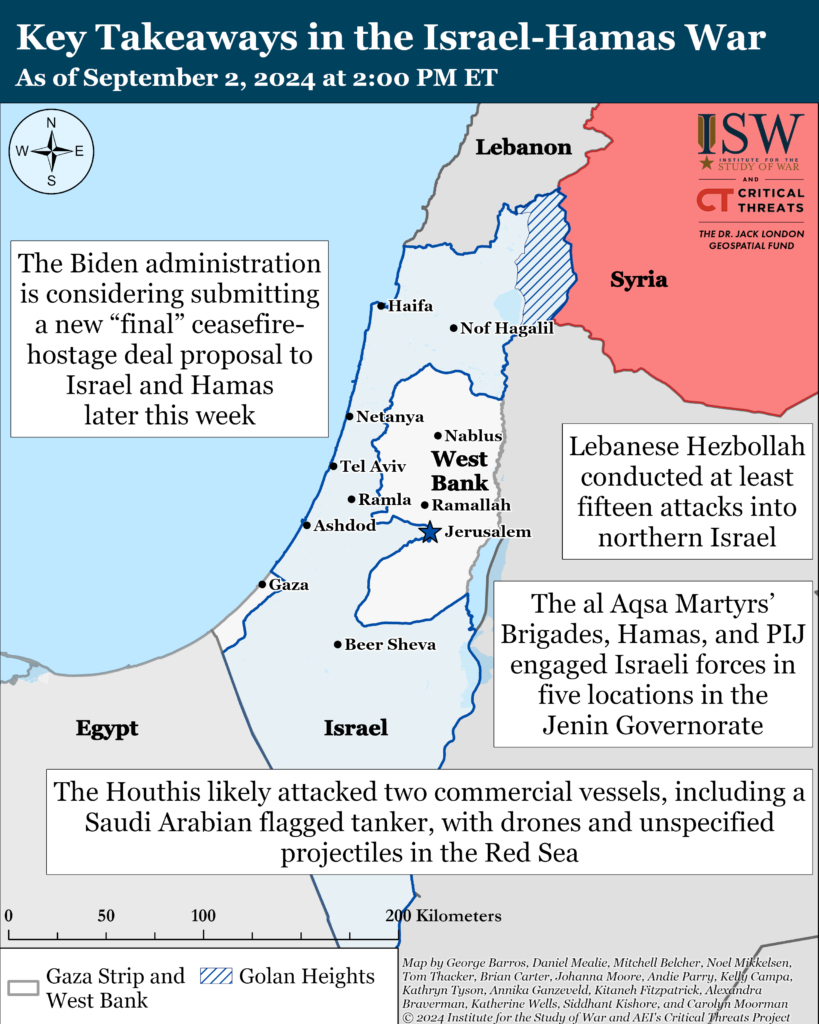
Gaza Strip
Axis of Resistance objectives:
Erode the will of the Israeli political establishment and public to sustain clearing operations in the Gaza Strip
Reestablish Hamas as the governing authority in the Gaza Strip
A humanitarian pause continued for a second day on September 2 in the central Gaza Strip to enable humanitarian aid groups to start a mass polio vaccination campaign.[42] The Israeli Prime Minister’s Office has emphasized that the pause is not related to the longer-term ceasefire proposal currently under discussion in Doha.[43] Humanitarian aid groups are administering the vaccines to Gazan children over three days during eight-hour humanitarian pauses in the central Gaza Strip.[44] Israel will also conduct three day pauses in designated areas of the southern and northern Gaza Strip from September 4 to 9.[45] Palestinian and UN officials said health workers vaccinated more than 80,000 children in the central Gaza Strip on September 1.[46]
Local Palestinian sources reported that the IDF continued to conduct limited military operations outside of the vaccination ceasefire zones in the Gaza Strip during the humanitarian pause. Palestinian sources reported small arms fire and shelling south of Gaza City and along the Netzarim Corridor on September 2, indicating that Israeli ground operations have continued in the northern Gaza Strip.[47] The Israel Defense Forces (IDF) 252nd Division last acknowledged it operated in Gaza City on August 31.[48]
Palestinian militias conducted at least one rocket attack targeting Israeli forces near the Netzarim Corridor, south of Gaza City.[49]
The al Aqsa Martyrs’ Brigades mortared Israeli forces east of Rafah City on September 2.[50]
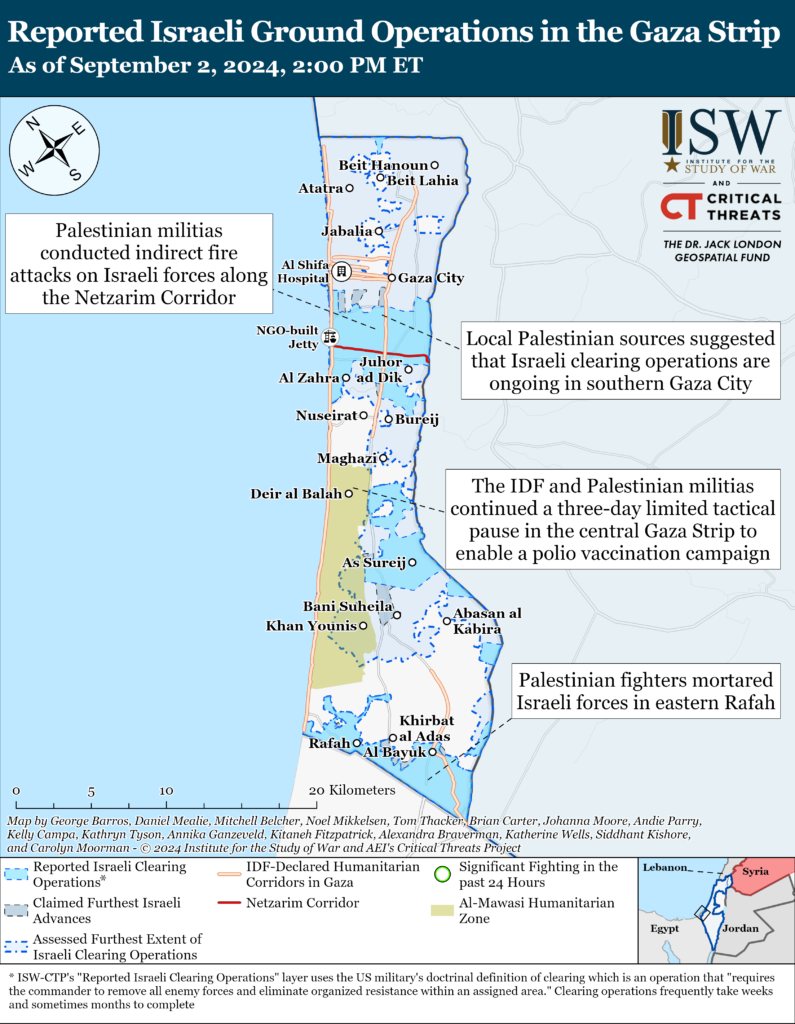
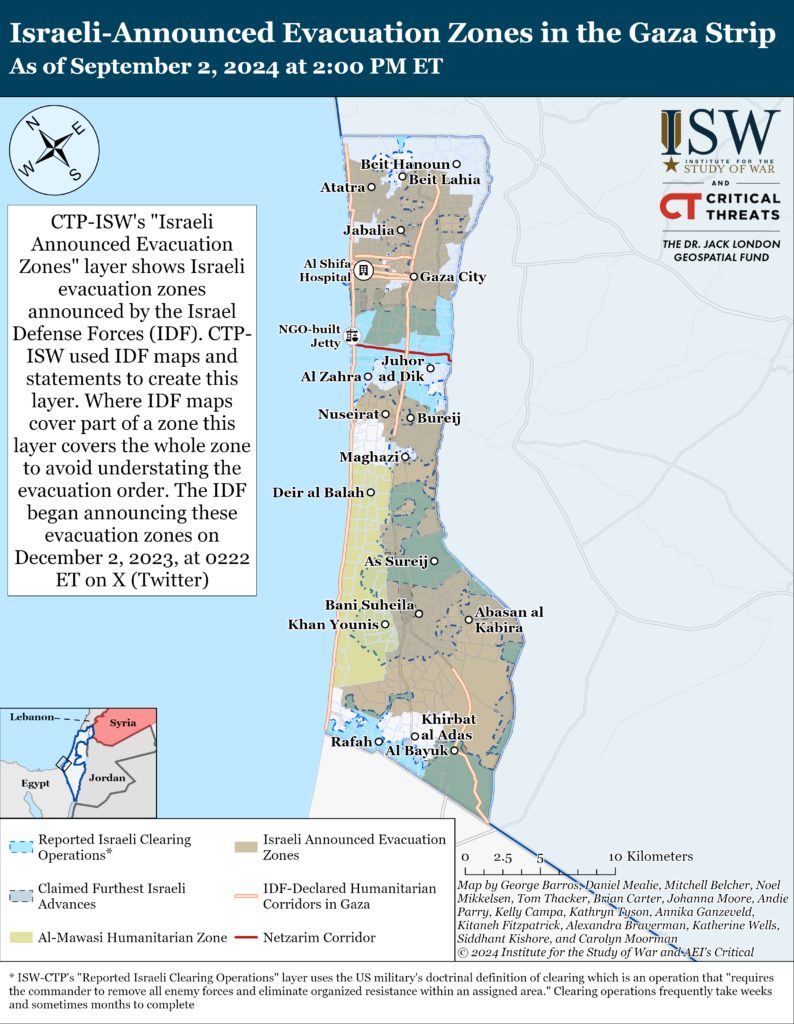
The al Aqsa Martyrs’ Brigades fired rockets and mortars at an IDF site in southern Israel after CTP-ISW’s data cutoff on September 1.[51]
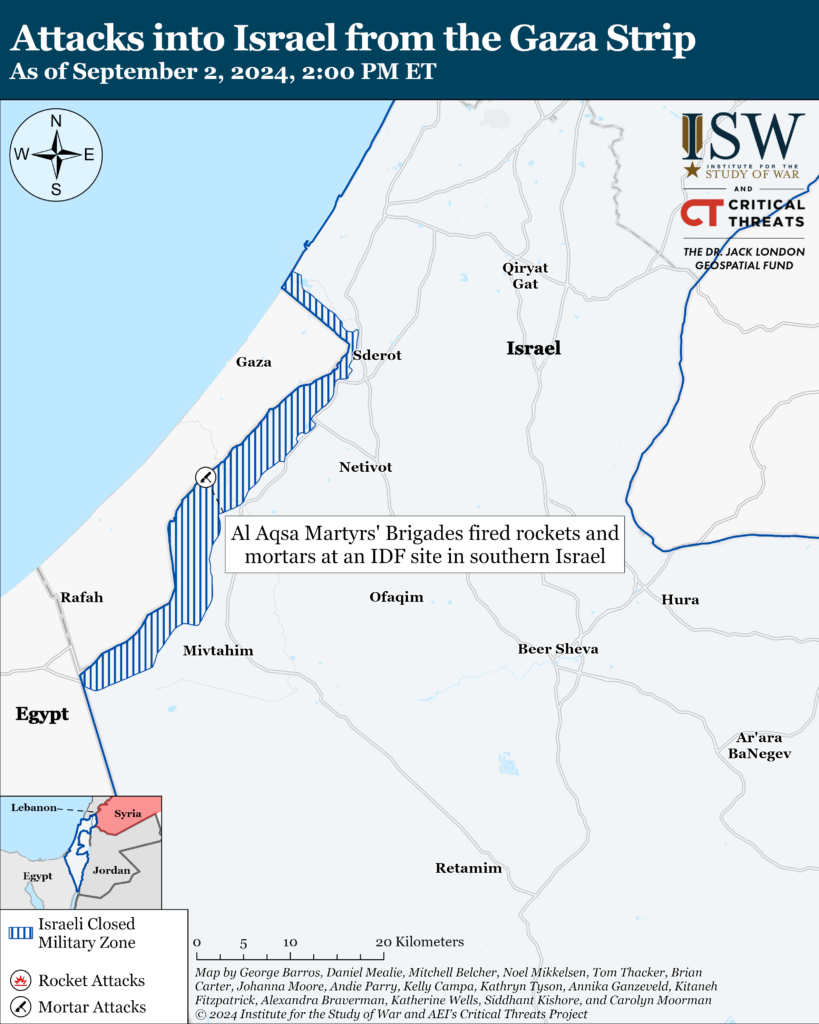
Recorded reports of attacks; CTP-ISW cannot independently verify impact.
West Bank
Axis of Resistance objectives:
Establish the West Bank as a viable front against Israel
The IDF continued raids in Jenin for the seventh consecutive day as part of the IDF effort to degrade Palestinian militia networks in the West Bank. The IDF conducted an airstrike targeting Palestinian fighters who had thrown improvised explosive devices (IED) at Israeli forces in Jenin.[52] The IDF also published pictures of IEDs that it uncovered in a cemetery in Jenin.[53]
The al Aqsa Martyrs’ Brigades, Hamas, and PIJ engaged Israeli forces in five locations in the Jenin Governorate since CTP-ISW’s last data cutoff on September 1.[54]
The IDF thwarted a possible car bomb attack near an Israeli settlement north of Ramallah on September 2.[55] The IDF identified a suspicious vehicle near Ateret settlement and are currently investigating the incident.[56] The IDF destroyed “gas canisters” found in the car and said that the cannisters were wired up to a detonator. [57] The incident follows two car bombings in Gush Etzion in the West Bank on August 30.[58]
The al Aqsa Martyrs’ Brigades and Hamas separately claimed two car bombings in Gush Etzion on August 30.[59] The al Aqsa Martyrs’ Brigades and Hamas claimed responsibility for the attack on September 1 and 2, respectively.[60] Neither group specified whether they coordinated the attacks. The al Aqsa Martyrs’ Brigades and Hamas acknowledged the deaths of two Palestinian fighters who Israeli forces killed shortly after the attacks.[61] Both groups threatened further attacks against Israeli civilians and security forces in the West Bank.[62]
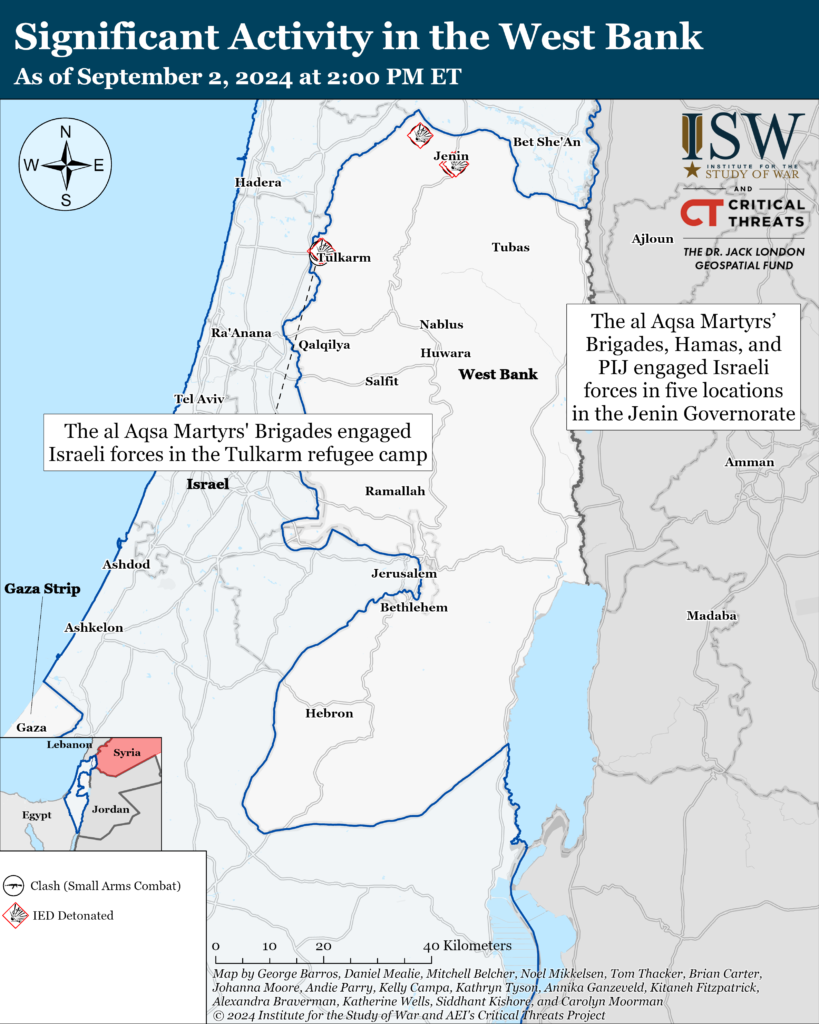
This map is not an exhaustive depiction of clashes and demonstrations in the West Bank.
Southern Lebanon and Golan Heights
Axis of Resistance objectives:
Deter Israel from conducting a ground operation into Lebanon
Prepare for an expanded and protracted conflict with Israel in the near term
Expel the United States from Syria
Lebanese Hezbollah conducted at least 15 attacks into northern Israel since CTP-ISW’s last data cutoff on September 1.[63]

Iran and Axis of Resistance
Iraqi Prime Minister Mohammad Shia al Sudani met with Combined Joint Task Force Operation Inherent Resolve commander Major General Kevin Leahy and US Ambassador to Iraq Alina Romanowski on September 2 to discuss transitioning the international coalition’s mission to bilateral security partnerships.[64] Sudani, Leahy, and Romanowski discussed continuing training, “expertise,” and intelligence sharing with Iraqi security forces after the international coalition’s mission in Iraq concludes. The United States and Iraq are evaluating a timeline to end the international coalition’s mission in Iraq based on threats posed by ISIS in Iraq and the Iraqi Security Forces (ISF) capabilities to conduct independent counter-ISIS operations.[65] The ISF still face significant deficiencies in fire support, intelligence, and logistics that would impede their ability to eliminate ISIS and other domestic threats alone.[66] The international coalition reportedly delayed its announcement of a timeline for a US troop withdrawal from Iraq due to ”recent events” according to a statement from the Iraqi Foreign Affairs Ministry on August 15.[67]
Iranian President Masoud Pezeshkian primarily discussed economic issues in his first televised interview on August 31.[68] Pezeshkian stated that his administration will strive to reduce inflation to 30 percent by the end of the current Persian calendar year, which ends in March 2025. Inflation in Iran is currently above 40 percent.[69] Pezeshkian also stated that Iran requires over $100 billion in foreign investment in order to achieve its target of eight percent annual economic growth. Pezeshkian stated that he will try to attract investments from Iranians living abroad during his second foreign trip to attend the United Nations General Assembly meeting in New York between September 22 and 23.[70] Pezeshkian emphasized that his administration will try to resolve economic difficulties faced by teachers, nurses, pensioners, and farmers. Nurses across Iran have gone on strike to protest unpaid wages and poor working conditions since early August 2024.[71]
Iranian Foreign Affairs Minister Abbas Araghchi discussed the ongoing ceasefire-hostage negotiations between Israel and Hamas with his Jordanian, Bulgarian, and Irish counterparts. Araghchi claimed that Israel is the “biggest obstacle” to achieving a ceasefire agreement during a phone call with Jordanian Deputy Prime Minister and Foreign Affairs Minister Ayman al Safadi on August 30.[72] Araghchi stated that Iran will accept any ceasefire agreement accepted by Hamas during separate phone calls with his Bulgarian and Irish counterparts on September 1 and 2, respectively.[73] Islamic Revolutionary Guards Corps (IRGC) Quds Force Deputy Brigadier General Eraj Masjedi similarly expressed support for Hamas’ maximalist ceasefire demands on September 1.[74]
Iranian Defense Minister Aziz Nasir Zadeh spoke to Syrian Defense Minister Lieutenant General Ali Mahmoud Abbas about bilateral relations over the phone on September 1.[75] Nasir Zadeh explained that cooperation between Syria and Iran will “definitely cause the defeat” of Israel.
The United Kingdom sanctioned three Islamic Revolutionary Guards Corps Quds Force (IRGC-QF) members and one IRGC-QF unit on September 2.[76] The United Kingdom sanctioned the following individuals and unit:
Hamid Fazeli: Fazeli is the commander of IRGC-QF Unit 340.[77] Unit 340 is responsible for providing technical military support and training to members of the Axis of Resistance.[78] Fazeli has given “support or assistance to armed groups threatening, planning or conducting activity intended to cause the destabilization of Israel.”[79]
Behnam Shahriyari: Shahriyari has facilitated “the planning or conducting of activity which is intended to cause the destabilization of Israel, Iraq, Yemen and Lebanon.”[80] The United States designated Shahriyari as a Specially Designated National in 2011 for “acting on behalf of IRGC-linked shipping company that provided material support, including weapons, to Hezbollah.”[81]
Abdolfatah Ahvazian: Ahvazian is an adviser to IRGC-QF Commander Brigadier General Esmail Ghaani.[82] Ahvazian has been involved in “threatening, planning or conducting activity which is intended to cause the destabilization of the United Kingdom or any other country.”[83]
IRGC-QF Unit 700: IRGC-QF Unit 700 has facilitated “the planning or conducting of activity which is intended to cause the destabilization of the United Kingdom or any other country.”[84]
Iranian Supreme Leader Ali Khamenei appointed former acting foreign affairs minister and diplomat Ali Bagheri Kani as a member of the Strategic Foreign Relations Council on August 31.[85] This council is a foreign affairs advisory board to the Supreme Leader and is currently chaired by Kamal Kharazi. Bagheri Kani served as the Iranian deputy foreign affairs minister for political affairs under former President Ebrahim Raisi.
Iranian Oil Minister Mohsen Paknejad appointed Saeed Tavakoli as CEO of the National Iranian Gas Company on September 2.[86] Tavakoli has previously held senior positions in other Iranian gas companies.[87] Iranian Oil Minister Mohsen Paknejad appointed Hamid Boord as the CEO of the National Iranian Oil Company on August 29.
Iranian security forces arrested a Jaish al Adl fighter in Sistan and Baluchistan Province on August 31.[88] Jaish al Adl is a Baloch Salafi-jihadi group that operates along the Iranian border with Pakistan. CTP-ISW has previously noted an uptick in anti-regime militancy and unrest in southeastern Iran since December 2023.
The Houthis likely conducted two attacks on merchant vessels in the Red Sea on September 2.[89] The United Kingdom Maritime Trade Operations (UKMTO) reported that two unspecified projectiles hit Panama flagged and Greek-operated Blue Lagoon I and another projectile exploded near the vessel 70 nautical miles northwest of al Saleef, Yemen.[90] UKMTO reported a drone attack on a commercial vessel approximately 58 nautical miles west of al Hudaydah, Yemen. Reuters reported that the second vessel that UKMTO did not specify was Saudi-flagged and owned oil tanker Amjad.[91]
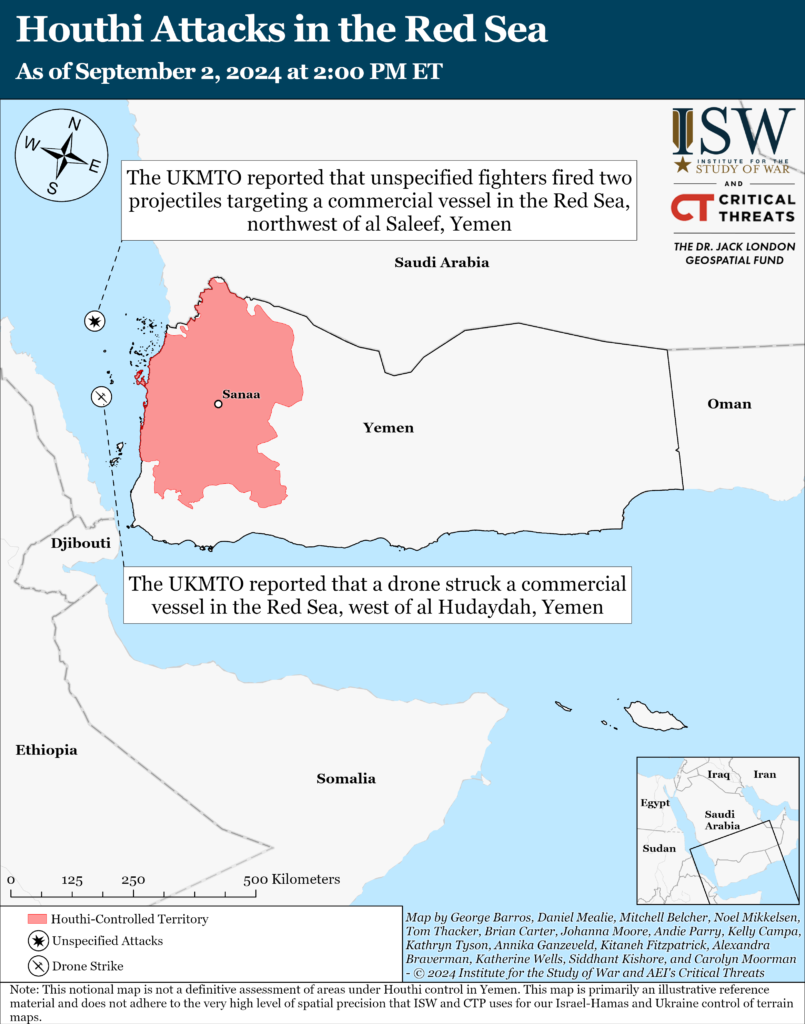
 Eurasia Press & News
Eurasia Press & News
